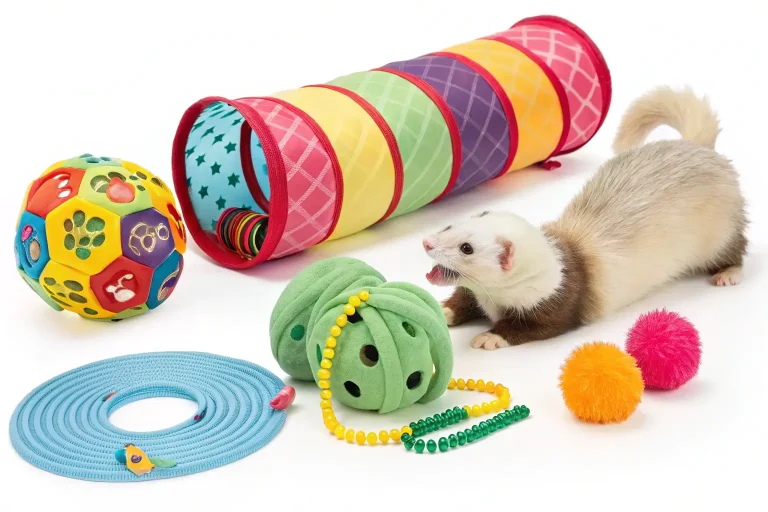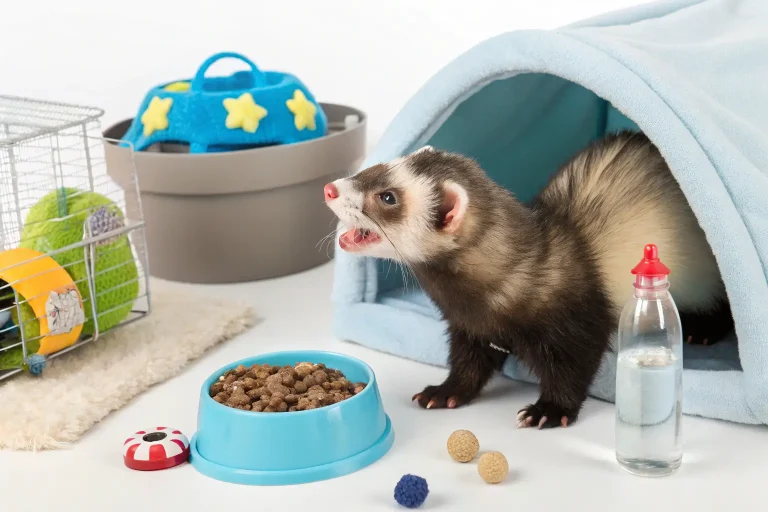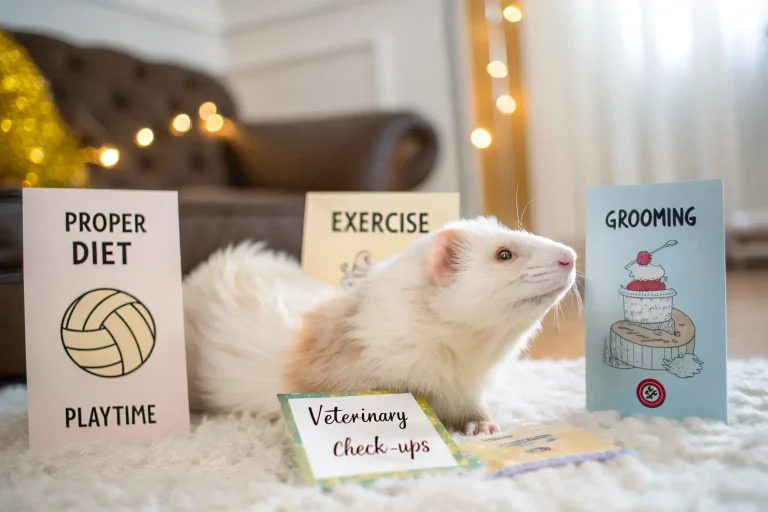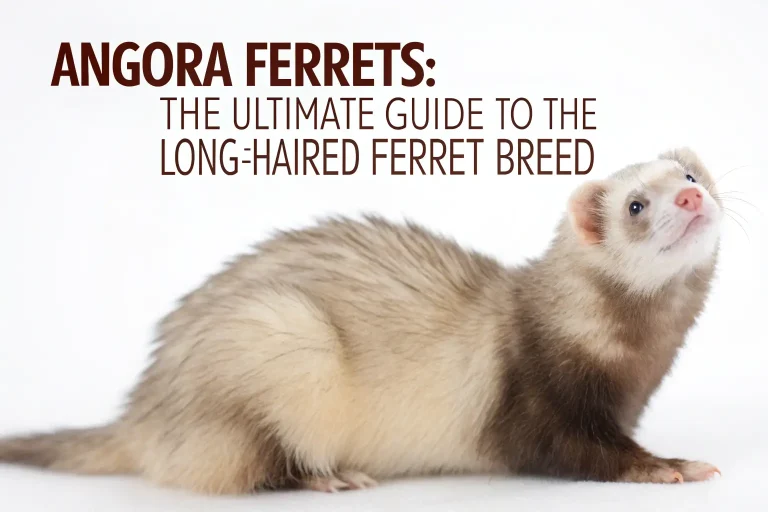How Coco the Ferret Charms Everyone: 7 Cute Antics You’ll Love!
Curious about ferret behaviors? See how Coco the ferret steals hearts with 7 adorable habits. Fall in love with her playful charm & get expert tips. Discover more!
Introduction
With her sleek fur, boundless energy, and mischievous eyes, Coco the ferret has captured hearts across social media and in her own home. This pint-sized bundle of curiosity embodies everything that makes ferrets such beloved companions. Coco the ferret isn’t just another pet – she’s a personality, a tiny adventurer whose antics can transform even the gloomiest day into one filled with laughter.
Understanding ferrets like Coco helps us appreciate the unique joy these domesticated polecats bring to our lives. Whether you’re considering adding a ferret to your family or simply fascinated by these playful creatures, Coco’s story offers a window into the delightful world of ferret companionship.
Did you know that despite their small size, ferrets like Coco can sleep for up to 18 hours a day – yet when awake, demonstrate such explosive energy and playfulness that you’d never guess they spend three-quarters of their life napping?
Species Overview
Scientific Name: Mustela putorius furo
Physical Characteristics: Coco the ferret displays the classic ferret physique – a long, slender body measuring about 20 inches from nose to tail tip, weighing approximately 1.5-4 pounds. Her plush double coat features a beautiful sable coloration (dark brown) with cream underparts, though ferrets like Coco can come in various colors including albino, cinnamon, and patterned varieties. Coco’s most striking features include her bright, inquisitive eyes, sensitive whiskers, and the mask-like facial markings that give her an eternally curious expression.
Subspecies: Domesticated ferrets like Coco don’t have true subspecies but rather color variations and breeding lines. Domestic ferrets all belong to a single subspecies (Mustela putorius furo) derived from the European polecat. Selective breeding has created differences in size, coloration patterns, and temperament, but Coco and all her domestic ferret companions share the same taxonomic classification.
Habitat and Distribution
Natural Habitat: While Coco the ferret enjoys the comforts of her human home, her wild ancestors thrived in diverse environments including woodlands, grasslands, and near farmlands. Domestic ferrets like Coco have been companion animals for over 2,000 years, with evidence suggesting they were originally domesticated to hunt rabbits and rodents.
Geographic Range: Wild polecats (ferrets’ ancestors) are native to Europe and parts of North Africa and Asia. As domesticated animals, ferrets like Coco now live worldwide as pets, though keeping ferrets is prohibited in some locations like California, Hawaii, and parts of New York City due to concerns about potential ecological impact if released.
Adaptations: Though fully domesticated, Coco still exhibits adaptations from her wild ancestors. Her tubular body allows her to navigate narrow tunnels and tight spaces – a trait Coco demonstrates when exploring behind furniture or within blanket forts. Her sharp claws and teeth, while now used mostly for play, reflect her species’ predatory past. Perhaps most charming is her cache-hiding behavior – Coco frequently “steals” and hides favorite toys and household items, an adaptation from wild ferrets’ food-storing instincts.
Diet and Feeding Habits
What It Eats: Coco the ferret requires a high-protein, meat-based diet reflecting her obligate carnivore status. Her dietary needs include 30-40% protein and 15-20% fat content. Commercial ferret kibble forms the foundation of her diet, supplemented with occasional treats like small pieces of cooked egg or meat.
Hunting or Foraging Behavior: Though Coco doesn’t need to hunt, her play behaviors mirror natural hunting instincts. She pounces on toys, performs the characteristic “weasel war dance” (a sideways hopping behavior), and demonstrates impressive problem-solving abilities to access treats or interesting objects. Coco’s play-hunting combines stealth approaches with sudden bursts of activity – behaviors her wild relatives would use to catch prey.
Dietary Needs: Unlike many pets, Coco requires constant access to food due to her high metabolism and short digestive tract. She eats small amounts frequently throughout her active periods, processing food in as little as 3-4 hours. Proper nutrition is critical for Coco’s health, as ferrets can develop insulinoma (pancreatic tumors) when fed improper diets high in carbohydrates or sugars.
Behavior and Social Structure
Social Behavior: Coco the ferret demonstrates the deeply social nature characteristic of domestic ferrets. In the wild, ferrets may be somewhat solitary, but domestication has enhanced their sociability. Coco thrives on interaction with both humans and other ferrets, showing distinct preferences for certain playmates and activities. She enjoys being part of a “business” (the term for a group of ferrets) and engages in communal sleeping and play behaviors.
Communication: Coco communicates through a fascinating repertoire of sounds and body language. Her excited “dook-dook-dook” chatter indicates playfulness, while hissing signals fear or discomfort. When particularly happy or excited, Coco performs the famous “weasel war dance” – a chaotic sideways hopping accompanied by arched back and puffed tail that never fails to delight observers. Her body language is equally expressive; a flattened posture indicates fear, while a relaxed, loose demeanor shows contentment.
Mating and Reproduction: While Coco has been spayed for her health and behavioral benefits, intact female ferrets like her have unique reproductive physiology. They are induced ovulators, meaning they remain in heat unless bred or given hormonal treatment. This can lead to health complications including anemia if not addressed. Female ferrets have gestation periods of about 42 days, producing litters of 4-8 kits that are born deaf, blind, and completely dependent. Mothers like Coco would naturally be devoted parents, caring for young until 8-12 weeks of age.
Conservation Status
Endangerment Level: Domestic ferrets like Coco aren’t endangered; they’re thoroughly domesticated animals bred specifically as companions. However, their wild relatives face various challenges. The European polecat (Mustela putorius) is listed as Least Concern on the IUCN Red List, while the black-footed ferret (Mustela nigripes) of North America has faced near-extinction and remains Endangered despite recovery efforts.
Threats: While Coco enjoys safety in her home, domestic ferrets face challenges including breed-specific legislation in some regions and misconceptions about their care requirements. Their specialized needs and mischievous nature mean they’re sometimes surrendered to shelters when owners are unprepared for their care.
Conservation Efforts: Conservation primarily focuses on wild ferret relatives. The black-footed ferret recovery program represents one of America’s most successful endangered species comebacks, with captive breeding and reintroduction increasing populations from just 18 individuals in the 1980s to several hundred today. For domestic ferrets like Coco, rescue organizations work to place surrendered or abandoned ferrets in appropriate homes.
Interesting Facts
Sleepy Thieves: Like Coco, ferrets sleep 14-18 hours daily but make up for it with intense bursts of activity. Their name derives from Latin “furittus,” meaning “little thief,” reflecting their tendency to steal and hide treasured items.
Historical Helpers: Before electronic devices, ferrets like Coco were used to run wiring through pipes and narrow spaces due to their flexible bodies and curious nature.
Remarkable Memory: Coco can remember solutions to problems for years, demonstrating impressive long-term memory despite her seemingly carefree personality.
Unique Digestion: A ferret’s digestive tract is so short that food passes through in just 3-4 hours, compared to 24+ hours in humans – explaining Coco’s frequent small meals.
Cultural Significance: Ferrets like Coco have appeared throughout history – from Leonardo da Vinci’s “Lady with an Ermine” (actually depicting a ferret) to modern films like “Kindergarten Cop” and “Along Came Polly.”
Legal Status: Despite being domestic animals for millennia, ferrets remain illegal in some places including California and Hawaii, making Coco’s residency status dependent on local laws.
Ballet Dancers: When excited, Coco performs what’s called a “weasel war dance” – a chaotic sideways hopping with an arched back that serves to confuse prey in the wild but mainly delights humans in domestic settings.
Tips for Caring for Coco the Ferret
Housing: Coco needs a multi-level cage with at least 6 cubic feet of space, featuring hammocks, tunnels, and sleeping areas. Ferret-proofing your home is essential before playtime, as Coco can squeeze through incredibly small spaces (roughly 1 inch in diameter) and may chew dangerous items like rubber or foam.
Diet: Feed Coco high-quality ferret kibble specifically formulated for her nutritional needs. Avoid cat food (insufficient protein), dog food (wrong nutritional balance), or foods containing sugars, grains, or vegetables. Ensure fresh water is always available.
Health Considerations: Regular veterinary care with an exotic pet specialist is crucial for Coco. Common health concerns include:
- Adrenal disease (treatable with implants or medication)
- Insulinoma (managed through diet and medication)
- Dental issues (requiring regular checks and occasional cleaning)
- Seasonal hair loss during spring and fall (normal but should be monitored)
Socialization and Enrichment: Coco requires at least 4 hours of out-of-cage time daily, divided into multiple play sessions. Rotate toys regularly to prevent boredom, and provide tunnels, dig boxes, and interactive puzzles. Social ferrets like Coco often thrive with ferret companions when properly introduced.
Hygiene: Clean Coco’s cage weekly, change bedding frequently, and spot clean daily. Bathe her only when necessary (every few months) to avoid stripping natural oils. Clean her ears weekly with a ferret-specific solution, and trim nails monthly.
Role in the Ecosystem
Ecological Importance: As a fully domesticated animal, Coco herself doesn’t play a role in natural ecosystems. However, her wild relatives are important mesopredators that help control rodent populations. The European polecat, ancestral to domestic ferrets like Coco, helps maintain ecological balance by regulating prey populations and dispersing seeds through their scat.
Impact of Decline: If wild ferret relatives declined, ecosystems would experience cascading effects. Rodent populations might increase unchecked, potentially damaging crops, spreading disease, and altering vegetation patterns through seed consumption. This illustrates the interconnectedness of predator-prey relationships in healthy ecosystems – something to remember when appreciating Coco’s wild cousins.
7 Cute Antics That Make Coco the Ferret Irresistible
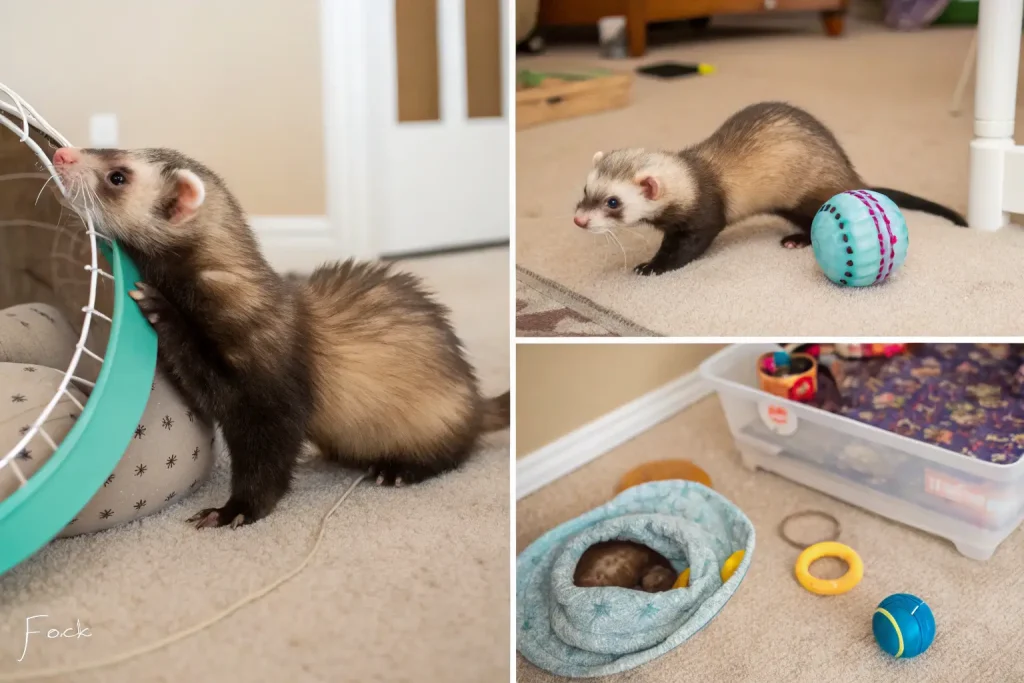
1. The Weasel War Dance
Perhaps Coco’s most charming behavior is her spontaneous “weasel war dance” – that frenzied, sideways hopping with an arched back and puffed tail. This seemingly chaotic dance, often accompanied by soft “dooking” sounds, expresses pure joy. When Coco encounters something new or exciting, she’ll bounce sideways across the floor, crash into furniture, recover with remarkable agility, and continue her jubilant performance. This dance, while serving to confuse prey in wild mustelids, is simply Coco’s way of expressing unbridled happiness.
2. Strategic Thievery
True to her species’ “little thief” reputation, Coco has perfected the art of stealthy theft. She demonstrates remarkable patience waiting for her opportunity to snatch prized items – socks, keys, phone cases – anything that catches her fancy. Most amusing is her confidence that no one notices as she drags items sometimes larger than herself across open floors, occasionally stopping to rest but never abandoning her prize until it’s safely stashed in her secret hideaway.
3. The Reverse-Burrowing Technique
Coco displays the characteristic ferret burrowing behavior with a comedic twist. Rather than only digging forward, she often backs up into blankets, tunnels, or clothing, wiggling backward until only her little nose remains visible. This reverse-burrowing technique creates irresistible photo opportunities as she peeks out from her cozy hideaways, looking simultaneously mischievous and adorably vulnerable.
4. The Dead Sleep
Few things are more endearing than Coco in deep sleep. Unlike many animals, ferrets sleep so profoundly that they can be picked up, repositioned, even gently rolled over without waking. This “dead sleep” behavior often alarms new ferret owners, but it’s perfectly normal. Coco might hang limply from her hammock, sprawl flat on her belly with legs stretched behind her (“speed bump” position), or curl into such a tight ball that she’s nearly unrecognizable – all while being completely unresponsive to moderate noise or movement around her.
5. The “I’m So Happy” Toilet Dance
Ferret owners recognize the distinctive post-bathroom celebration that Coco performs without fail. After using her litter box, she’ll burst forth with renewed energy, running and jumping with what seems like relief and celebration. This “happy dance” often involves racing at top speed through her play area, scaling furniture, and generally expressing what appears to be satisfaction at a job well done. While slightly less dignified than her other behaviors, it never fails to produce laughter.
6. The Stash Collection
Coco maintains meticulous collections of “treasured” items, organized by type in different hiding spots. One spot might contain only rubber items, another soft toys, and a third shiny objects. Her organizational skills are impressive, as she’ll work tirelessly to maintain these categorized stashes, moving items between locations if they don’t quite belong. Most remarkable is her ability to remember these caches even after weeks or months, returning to check on particularly valued possessions periodically.
7. The Curiosity Investigation
Perhaps Coco’s most defining characteristic is her boundless curiosity. New objects must be thoroughly investigated – sniffed, pawed, pushed, climbed on, and potentially claimed. Her investigation process follows a predictable pattern: cautious approach, tentative sniffing, gentle touch with front paws, and finally either enthusiastic play or determined attempts to add the item to her collection. This careful but persistent curiosity makes interactions with Coco endlessly entertaining, as even familiar environments become new adventures through her exploring eyes.
Conclusion
Coco the ferret represents everything wonderful about these intelligent, playful companions. From her characteristic war dance to her strategic thievery, she displays the full spectrum of ferret behaviors that have endeared these animals to humans for centuries. Understanding Coco’s natural instincts helps us appreciate her unique personality while providing the specialized care she requires.
For those considering a ferret companion, Coco’s story illustrates both the delights and responsibilities of ferret ownership. These aren’t low-maintenance pets – they need specific nutrition, veterinary care, safe environments, and plenty of enrichment and social interaction. However, the rewards of sharing your home with a character like Coco are immeasurable.
Whether you’re already a ferret enthusiast or just beginning to learn about these fascinating creatures, remember that supporting ethical breeding practices, adopting from rescues when possible, and educating others about proper ferret care helps ensure these remarkable animals receive the love and attention they deserve. Consider supporting ferret welfare organizations or, if you have the resources and commitment, opening your home to a ferret in need of adoption.
Coco’s antics remind us that sometimes the smallest companions bring the greatest joy – and that the bond between humans and animals enriches both our lives immeasurably.
Frequently Asked Questions
How long do ferrets like Coco typically live?
With proper care, ferrets typically live 6-10 years. Factors affecting lifespan include genetics, diet quality, preventative healthcare, and early detection of common conditions like adrenal disease and insulinoma. Regular veterinary checkups can significantly extend Coco’s healthy years.
Is Coco the ferret’s musky smell a problem for homes?
Ferrets do have a natural musky odor from skin glands, but it’s much less pronounced in spayed/neutered ferrets like Coco who receive proper care. The smell can be managed through regular cage cleaning, occasional bathing (no more than monthly to avoid increasing oil production), and washing bedding. Many ferret owners find they become accustomed to the scent over time.
What makes Coco the ferret different from keeping a cat or dog?
Unlike cats or dogs, ferrets like Coco require specialized diets, exotic veterinary care, and extensive ferret-proofing due to their ability to squeeze into tiny spaces. They sleep more (14-18 hours daily) but require more intensive supervision while awake due to their mischievous nature and tendency to chew hazardous materials. Their playful, interactive personalities make them more hands-on than many cats but more independent than most dogs.
How much does it cost to care for a ferret like Coco annually?
Annual costs for ferret care typically range from $500-1,000, including quality food ($250-400), veterinary care ($200-500+), bedding, toys, and supplies. Initial setup costs for cages, accessories, and ferret-proofing can exceed $300. Medical emergencies or chronic conditions may significantly increase these costs, making emergency savings important for ferret owners.
Can Coco the ferret be trained to use a litter box consistently?
Yes, ferrets can be litter trained, though usually not with 100% reliability like cats. Coco can learn to use corner litter boxes in her cage and play areas, but may occasionally miss, especially during excited play. Training involves consistent reinforcement, strategic placement of multiple boxes, and understanding that accidents will happen, particularly in new environments or during intense play sessions.
Is it true that ferrets like Coco need ferret companions to be happy?
While ferrets are social animals that often enjoy and benefit from ferret companionship, single ferrets like Coco can thrive with sufficient human interaction. A lone ferret requires more dedicated playtime (at least 4 hours daily in multiple sessions) and enrichment than those with ferret friends. If considering a companion for Coco, proper, gradual introductions are essential, as not all ferrets bond immediately.
What’s the most challenging aspect of caring for Coco the ferret?
Many ferret owners find that healthcare management presents the greatest challenge. Finding knowledgeable exotic veterinarians, managing conditions like adrenal disease or insulinoma that affect most aging ferrets, and budgeting for potentially expensive treatments top the list of concerns. Additionally, thorough and continuous ferret-proofing is critical, as Coco’s natural curiosity and ability to squeeze into small spaces can lead to dangerous situations if proper precautions aren’t maintained.


